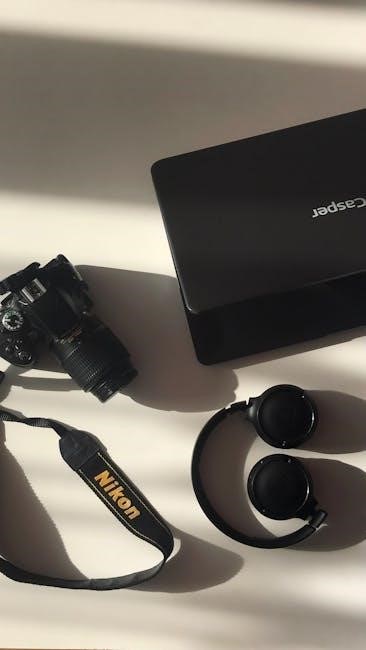Wookiees are a species of large‚ hairy mammalian humanoids in the Star Wars galaxy‚ with a rich history and culture‚ studied through various media‚ including films and television shows‚ providing insight into their biology and behavior naturally.
Physical Characteristics of Wookiees
Wookiees are a species of large‚ hairy mammalian humanoids‚ typically ranging in height from 1.8 to 2.3 meters‚ with a strong and muscular build‚ allowing them to be skilled warriors and hunters. They have thick‚ shaggy fur that covers their entire body‚ which can vary in color from dark brown to light brown‚ and even gray or white. Their eyes are typically yellow or brown‚ and their nose is flat and wide. Wookiees also have sharp teeth and retractable claws‚ which they use for climbing‚ hunting‚ and self-defense. Their physical characteristics are well adapted to their native planet of Kashyyyk‚ a forest-covered world with tall trees and dense foliage. Wookiees are also known for their exceptional strength‚ agility‚ and endurance‚ making them a formidable species in the Star Wars galaxy. Their physical appearance is often intimidating to other species‚ but they are also capable of great kindness and compassion. Overall‚ the physical characteristics of Wookiees are a key aspect of their identity and play an important role in their culture and society. They are a unique and fascinating species‚ with a rich history and biology.

Wookiee Culture and Society
Wookiees live in a complex society with strong family bonds and tribal affiliations naturally forming.
Wookiee Home Planet and Environment
The Wookiee home planet‚ Kashyyyk‚ is a forest-covered planet located in the southwestern quadrant of the Star Wars galaxy. This planet is characterized by its dense forests‚ wroshyr trees‚ and diverse wildlife. The environment on Kashyyyk is unique‚ with a variety of flora and fauna that have adapted to the planet’s conditions. The Wookiees have developed a deep connection with their environment‚ living in harmony with the natural world. Their homes‚ known as treetop villages‚ are built high above the forest floor‚ allowing them to coexist with the planet’s wildlife. The Wookiees’ understanding of their environment is rooted in their culture and traditions‚ which emphasize living in balance with nature. This connection to their environment has played a significant role in shaping the Wookiee way of life‚ influencing their social structures‚ beliefs‚ and values. Overall‚ the Wookiee home planet and environment are integral to their identity and play a vital role in their daily lives. The planet’s ecosystem is delicate‚ and the Wookiees work to maintain the balance of nature‚ ensuring the long-term survival of their species.

Wookiee Relationships and Interactions
Wookiees form close bonds with other species‚ like humans‚ through shared experiences and mutual respect‚ fostering trust and cooperation naturally.
Wookiee-Human Relationships
Wookiees and humans have a complex and multifaceted relationship‚ with a history of cooperation and mutual respect‚ as seen in the friendships between Wookiees like Chewbacca and humans like Han Solo‚ and the alliances formed during the Clone Wars and the Rebel Alliance‚ where Wookiees fought alongside humans against common enemies‚ and through these shared experiences‚ they developed a deep understanding and appreciation for each other’s cultures and values‚ leading to strong bonds and lasting relationships‚ and while there may be instances of conflict and mistrust‚ the overall trend is one of friendship and cooperation‚ with many humans and Wookiees working together to achieve common goals‚ and learning from each other’s unique perspectives and skills‚ and this relationship is further complicated by the fact that Wookiees are capable of forming romantic relationships with humans‚ as seen in the case of the Twilek‚ and the Wookiee Lowbacca‚ who was a companion of Jaina Solo‚ and through these relationships‚ we see the complexity and depth of Wookiee-human interactions‚ and the many ways in which they can form strong and meaningful bonds with each other‚ and navigate the challenges and opportunities of their relationships‚ and ultimately‚ the Wookiee-human relationship is one of mutual respect‚ trust‚ and cooperation‚ and is an important part of the Star Wars universe‚ and continues to evolve and grow as new stories and characters are introduced‚ and as we learn more about the complexities and nuances of Wookiee-human interactions‚ and the many ways in which they can form strong and lasting relationships‚ and work together to achieve common goals‚ and build a brighter future for all‚ and through their relationships‚ we see the best of what it means to be a Wookiee‚ and a human‚ and the many ways in which they can come together‚ and form strong and meaningful bonds‚ and navigate the challenges and opportunities of their relationships‚ and ultimately‚ build a better future for all‚ and learn from each other’s unique perspectives and skills‚ and grow and evolve as individuals‚ and as a community‚ and the Wookiee-human relationship is a powerful and enduring part of the Star Wars universe‚ and continues to inspire and captivate audiences‚ and to explore the complexities and nuances of Wookiee-human interactions‚ and the many ways in which they can form strong and meaningful bonds with each other.

Notable Wookiee Characters
Chewbacca and Lowbacca are notable Wookiees in the Star Wars universe‚ known for their bravery and loyalty‚ with unique personalities and skills‚ playing important roles in the series naturally.
Chewbacca and Lowbacca
Chewbacca‚ a loyal Wookiee‚ is a prominent character in the Star Wars series‚ known for his friendship with Han Solo and role as co-pilot of the Millennium Falcon. He appears in several films‚ including episodes III through IX‚ and Solo: A Star Wars Story. Lowbacca‚ on the other hand‚ is a Jedi Knight and Chewbacca’s nephew‚ who trained at Luke Skywalker’s Jedi Praxeum and wielded a bronze-bladed lightsaber. Both characters have unique personalities and skills‚ with Chewbacca’s loyalty and strength‚ and Lowbacca’s agility and intelligence‚ making them valuable members of the Star Wars universe. Their stories and interactions with other characters‚ including humans and other Wookiees‚ provide insight into the complexities of Wookiee relationships and culture. Through their adventures‚ Chewbacca and Lowbacca demonstrate the importance of loyalty‚ friendship‚ and family in Wookiee society‚ and their bond with each other and other characters is a key aspect of the Star Wars narrative‚ with their experiences shaping the galaxy far‚ far away. They are notable for their contributions to the Star Wars saga.

Wookiee Biology and Reproduction
Wookiees are a species of large‚ sentient‚ hairy mammalian humanoids‚ with a unique biology and reproductive system. They have a lifespan of several hundred years‚ and their physical characteristics‚ such as their height‚ strength‚ and hairiness‚ are influenced by their genetic makeup. Wookiees are also known to have a strong connection to their natural environment‚ and their biology is adapted to their native planet of Kashyyyk. Their reproductive system is not fully understood‚ but it is believed to be similar to that of other mammals‚ with a gestation period and birth process that is unique to their species. The study of Wookiee biology and reproduction is an important area of research‚ as it can provide insights into the evolution and development of this complex and fascinating species; Through the study of Wookiee biology‚ scientists can gain a deeper understanding of the intricate relationships between species and their environments‚ and the complex processes that shape the natural world. This knowledge can also inform conservation efforts and promote a greater appreciation for the diversity of life in the galaxy. Wookiee biology is a complex field of study.

























